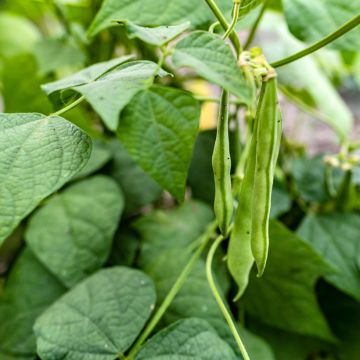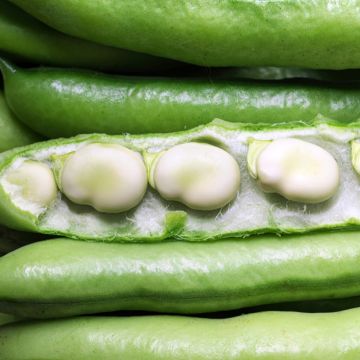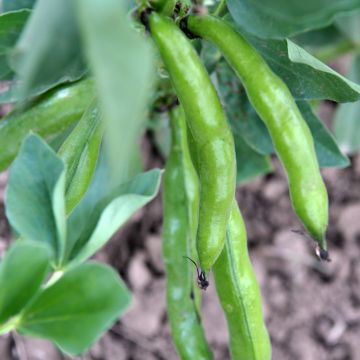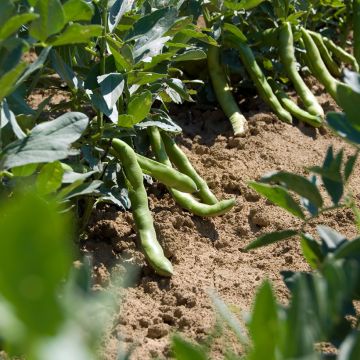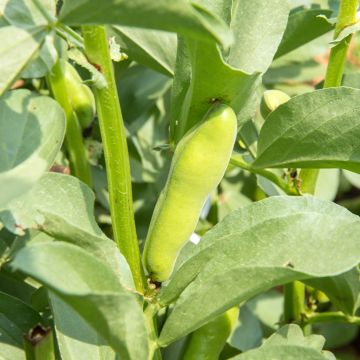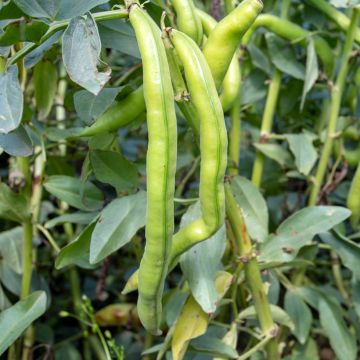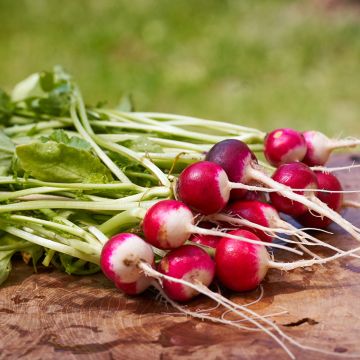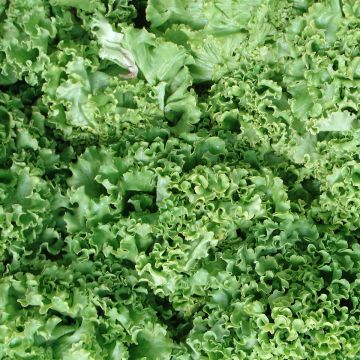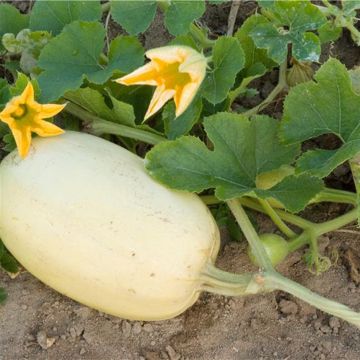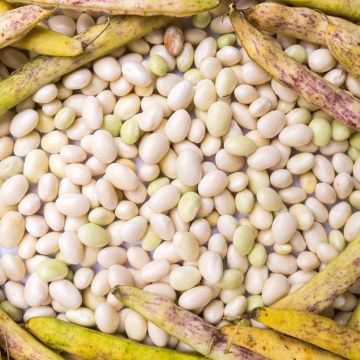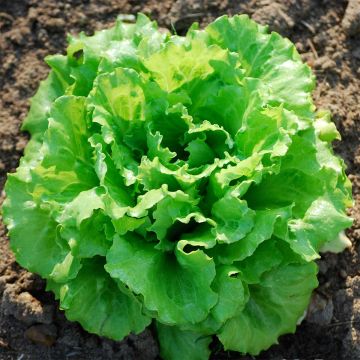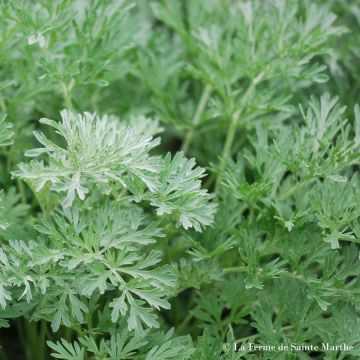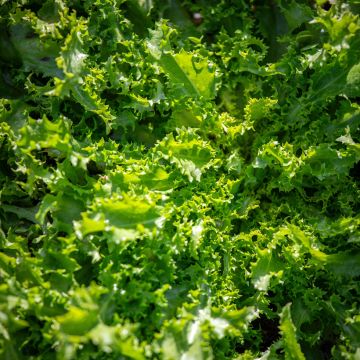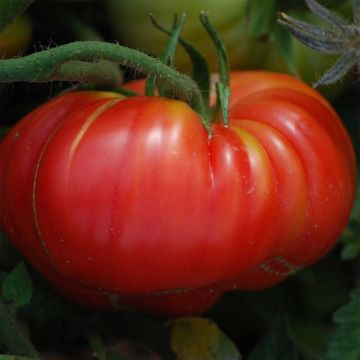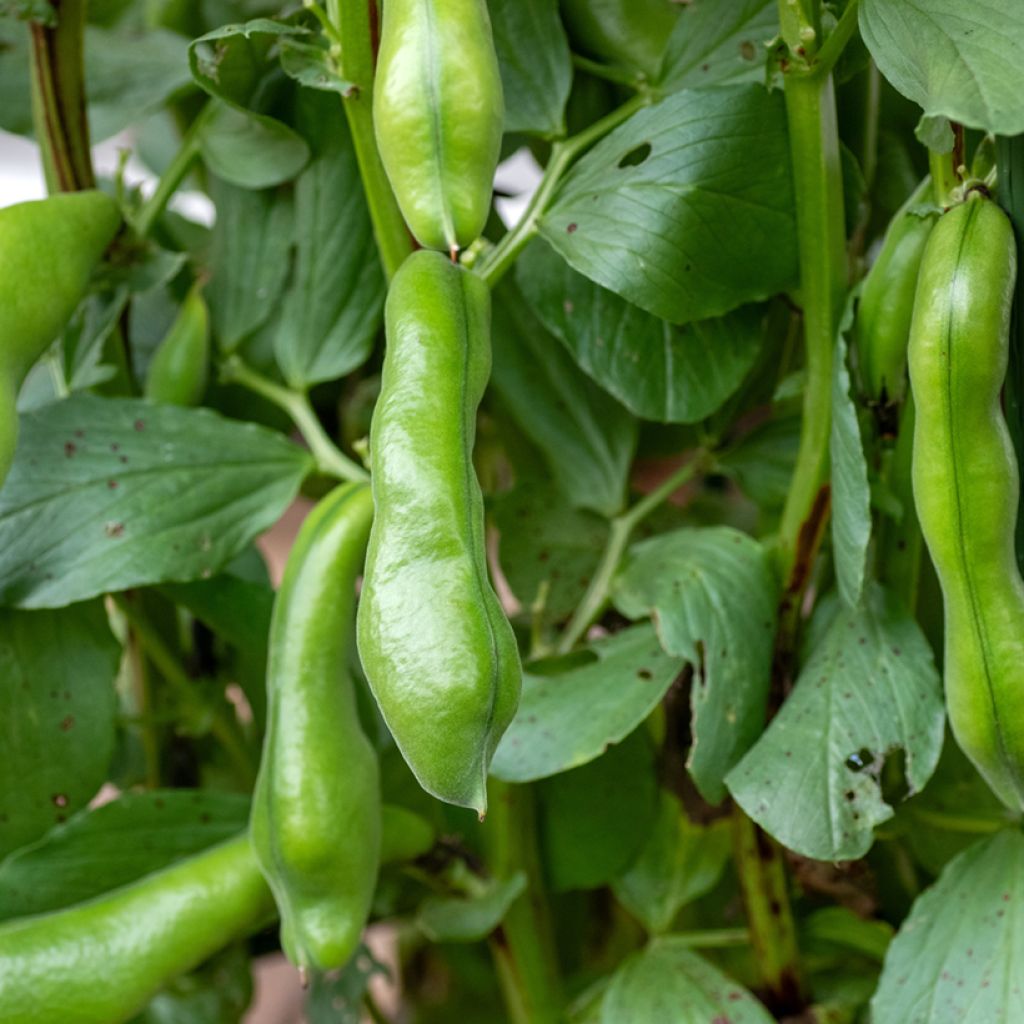

Broad Bean Witkiem Vroma
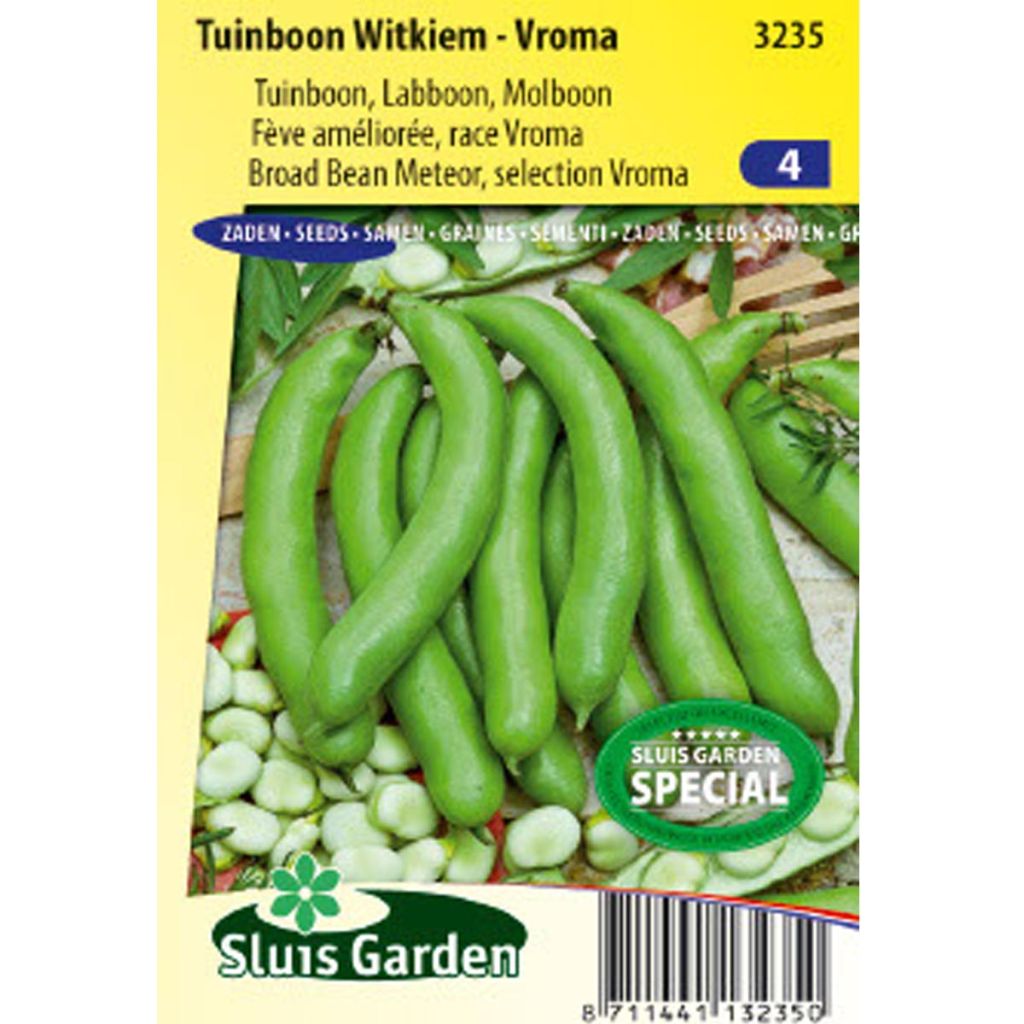

Broad Bean Witkiem Vroma
Broad Bean Witkiem Vroma
Vicia faba Witkiem Vroma
Fava bean
This item cannot be shipped to the selected country
Dispatch by letter from €3.90
More information
Schedule delivery date,
and select date in basket
This plant carries a 6 months recovery warranty
More information
We guarantee the quality of our plants for a full growing cycle, and will replace at our expense any plant that fails to recover under normal climatic and planting conditions.
Seed-only orders are dispatched by sealed envelope. The delivery charge for seed-only orders is €3.90.

Description
'Witkiem Vroma' Broad bean is a very early-maturing, vigorous and productive improved variety. It forms an abundance of pods filled with tasty brown beans. This excellent quality RHS AGM winner is sown from October to November or February to April depending on the climate.
The Broad bean (Vicia faba), also known as the Fava bean, is a legume that belongs to the large Fabaceae family alongside regular beans and peas. It is thought to originate from Asia and the Middle East and is now cultivated worldwide for its excellent flavour and nutritional value. Broad beans contain high levels of vegetable protein, fibre, minerals and vitamins including folate (vitamin B9). The kidney-shaped or rounded seeds come in a variety of sizes and colours, from white to green, brown or even purple. They can be eaten both raw and cooked. They are especially tasty picked young, fresh and tender - when harvested early they can even be eaten whole, pods included. It is also possible to leave them to mature on the plants and to harvest them dry. Preparing broad beans is a labour of love… but they’re worth it! First, the seeds are removed from the tough outer pods. Then (unless they are picked young enough) they are freed from their soft, bitter inner skin. Generally, 1 kg of raw pods yields 250 g of beans.
Broad beans are very easy to grow! They can be cultivated successfully in a much wider range of soil types than regular beans, although best results will be achieved in loamy, well-drained, moisture retentive soil. Like all members of the Fabaceae family, they are not heavy feeders. As nitrogen fixing plants, they are often used in crop rotations to enrich the soil before or after plants that require lots of nitrogen to grow. In milder climates, broad beans can be sown from November to February for early spring harvests.
Harvest: broad beans can be harvested at all stages of maturity: young for fresh, tender unshelled beans, slightly later for cooking, or dry for storing.
Storage: fresh beans will keep for a few days in the fridge. They can also be dried and stored in airtight jars or frozen for later use.
Good to know: Blackfly is an aphid that commonly affects broad bean crops. It can be kept in check without resorting to chemical insecticides: try spraying your crops with soapy water (2 tablespoons of liquid soap per litre of water). Some people choose to leave blackfly on their crops as a way to promote fruit set whilst attracting more ladybirds into their garden!
Report an error about the product description
Harvest
Plant habit
Foliage
Botanical data
Vicia
faba
Witkiem Vroma
Fabaceae
Fava bean
Cultivar or hybrid
Annual
Other Broad bean seeds
Planting and care
La germination de la Fève intervient à une température minimale de 8°. La levée prend entre 8 et 30 jours.
Le semis s’effectue d’octobre à fin novembre dans la moitié Sud-Ouest ou sous abri partout ailleurs pour une récole de mi-mai à fin juin. Dans le reste de la France, la période de semis s’étale de début février à fin avril pour une récole de mi-juin à fin août.
Les jeunes plants de Fève tolèrent des températures négatives mais ne résistent pas à plusieurs jours à – 5 °, pensez donc, si vous faite un semis d’hiver ou si la fin de l’hiver est glaciale, à les abriter sous un petit tunnel nantais.
Au soleil, sur sol décompacté, juste griffé, tracez des sillons espacés de 40 à 50 cm, d’une profondeur de 3 à 4 centimètres. Semez en ligne en espaçant les graines de 5 cm et recouvrez.
Culture :
La Fève est un légume frugal qui se plaît en terre lourde et humide. Elle ne réclame aucune fertilisation préalable et se sème en terre bien décompactée.
Lors de sa culture, il convient de butter les pieds lorsqu’ils atteignent une hauteur de 30 cm. Cela permet de stimuler la formation de nouvelles racines et leur garantit une meilleure stabilité. A la floraison, on pince traditionnellement le sommet de la plante afin de favoriser la formation des gousses et d’éliminer les pucerons qui ont tendance à s’y installer en priorité.
En région ventée, il est conseillé de tuteurer les Fèves (nous procédons chez nous un peu comme pour les framboisiers) afin que, chargées de gousses, elles ne versent lamentablement au premier coup de vent.
Coté association, la Fève est bonne voisine, en particulier car elle a la particularité de fixer l’azote dans le sol. Elle augmenterait la production du Chou pommé et de la Laitue. Pour éloigner les pucerons, vous pouvez également semer, entre les rangs de Fèves, du Basilic et de la Phacélie.
Seedlings
Care
Intended location
This item has not been reviewed yet - be the first to leave a review about it.
Vegetable seeds
Haven't found what you were looking for?
Hardiness is the lowest winter temperature a plant can endure without suffering serious damage or even dying. However, hardiness is affected by location (a sheltered area, such as a patio), protection (winter cover) and soil type (hardiness is improved by well-drained soil).

Photo Sharing Terms & Conditions
In order to encourage gardeners to interact and share their experiences, Promesse de fleurs offers various media enabling content to be uploaded onto its Site - in particular via the ‘Photo sharing’ module.
The User agrees to refrain from:
- Posting any content that is illegal, prejudicial, insulting, racist, inciteful to hatred, revisionist, contrary to public decency, that infringes on privacy or on the privacy rights of third parties, in particular the publicity rights of persons and goods, intellectual property rights, or the right to privacy.
- Submitting content on behalf of a third party;
- Impersonate the identity of a third party and/or publish any personal information about a third party;
In general, the User undertakes to refrain from any unethical behaviour.
All Content (in particular text, comments, files, images, photos, videos, creative works, etc.), which may be subject to property or intellectual property rights, image or other private rights, shall remain the property of the User, subject to the limited rights granted by the terms of the licence granted by Promesse de fleurs as stated below. Users are at liberty to publish or not to publish such Content on the Site, notably via the ‘Photo Sharing’ facility, and accept that this Content shall be made public and freely accessible, notably on the Internet.
Users further acknowledge, undertake to have ,and guarantee that they hold all necessary rights and permissions to publish such material on the Site, in particular with regard to the legislation in force pertaining to any privacy, property, intellectual property, image, or contractual rights, or rights of any other nature. By publishing such Content on the Site, Users acknowledge accepting full liability as publishers of the Content within the meaning of the law, and grant Promesse de fleurs, free of charge, an inclusive, worldwide licence for the said Content for the entire duration of its publication, including all reproduction, representation, up/downloading, displaying, performing, transmission, and storage rights.
Users also grant permission for their name to be linked to the Content and accept that this link may not always be made available.
By engaging in posting material, Users consent to their Content becoming automatically accessible on the Internet, in particular on other sites and/or blogs and/or web pages of the Promesse de fleurs site, including in particular social pages and the Promesse de fleurs catalogue.
Users may secure the removal of entrusted content free of charge by issuing a simple request via our contact form.
The flowering period indicated on our website applies to countries and regions located in USDA zone 8 (France, the United Kingdom, Ireland, the Netherlands, etc.)
It will vary according to where you live:
- In zones 9 to 10 (Italy, Spain, Greece, etc.), flowering will occur about 2 to 4 weeks earlier.
- In zones 6 to 7 (Germany, Poland, Slovenia, and lower mountainous regions), flowering will be delayed by 2 to 3 weeks.
- In zone 5 (Central Europe, Scandinavia), blooming will be delayed by 3 to 5 weeks.
In temperate climates, pruning of spring-flowering shrubs (forsythia, spireas, etc.) should be done just after flowering.
Pruning of summer-flowering shrubs (Indian Lilac, Perovskia, etc.) can be done in winter or spring.
In cold regions as well as with frost-sensitive plants, avoid pruning too early when severe frosts may still occur.
The planting period indicated on our website applies to countries and regions located in USDA zone 8 (France, United Kingdom, Ireland, Netherlands).
It will vary according to where you live:
- In Mediterranean zones (Marseille, Madrid, Milan, etc.), autumn and winter are the best planting periods.
- In continental zones (Strasbourg, Munich, Vienna, etc.), delay planting by 2 to 3 weeks in spring and bring it forward by 2 to 4 weeks in autumn.
- In mountainous regions (the Alps, Pyrenees, Carpathians, etc.), it is best to plant in late spring (May-June) or late summer (August-September).
The harvesting period indicated on our website applies to countries and regions in USDA zone 8 (France, England, Ireland, the Netherlands).
In colder areas (Scandinavia, Poland, Austria...) fruit and vegetable harvests are likely to be delayed by 3-4 weeks.
In warmer areas (Italy, Spain, Greece, etc.), harvesting will probably take place earlier, depending on weather conditions.
The sowing periods indicated on our website apply to countries and regions within USDA Zone 8 (France, UK, Ireland, Netherlands).
In colder areas (Scandinavia, Poland, Austria...), delay any outdoor sowing by 3-4 weeks, or sow under glass.
In warmer climes (Italy, Spain, Greece, etc.), bring outdoor sowing forward by a few weeks.

































